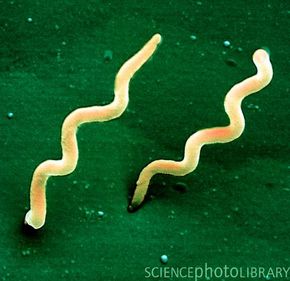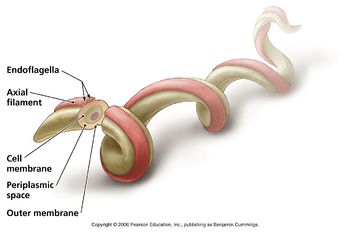Borrelia burgdorferi NEU2011: Difference between revisions
ChojnowskaA (talk | contribs) |
ChojnowskaA (talk | contribs) |
||
| Line 15: | Line 15: | ||
== Description and Significance == | == Description and Significance == | ||
Borellia burgdorferi is a spirochete which are cells that are both gram-negative and spiral-shaped with endoflagellum. The study of Borellia burgdorferi is very significant because it is the tick-borne agent of Lyme disease. Lyme disease is carried out by | ''Borellia burgdorferi'' is a spirochete which are cells that are both gram-negative and spiral-shaped with endoflagellum. The study of ''Borellia burgdorferi'' is very significant because it is the tick-borne agent of Lyme disease. Lyme disease is carried out by the bacterium, and transmitted through deer ticks which are known as ''Ixodes dammini'' (2). Lyme disease causes inflammation all around the body, arthritis, heart problems and can also affect the nervous system. | ||
== Genome Structure == | == Genome Structure == | ||
Revision as of 23:09, 29 March 2011
Borrelia burgforferi NEU2011
A Microbial Biorealm page on the genus Borrelia burgdorferi NEU2011
Classification
Higher order taxa
Domain- Bacteria; Phylum- Spirochaetes; Class- Spirochaetes; Order- Spirochaetales; Family- Spirochaetaceae; Genus- Borrelia; Species- Borellia burgdorferi
Description and Significance
Borellia burgdorferi is a spirochete which are cells that are both gram-negative and spiral-shaped with endoflagellum. The study of Borellia burgdorferi is very significant because it is the tick-borne agent of Lyme disease. Lyme disease is carried out by the bacterium, and transmitted through deer ticks which are known as Ixodes dammini (2). Lyme disease causes inflammation all around the body, arthritis, heart problems and can also affect the nervous system.
Genome Structure
The Borrelia burgdorferi genome contains 1.44 Mega base pairs with the number of G+C bases totaling 28%. It has a total of 22 DNA molecules including 21 extrachromosomal DNA elements, the largest known number of any bacterium (1). These include 12 linear and 9 circular plasmids which range from 5 to 56 kilobases (3). The plasmids contain a total of 1706 genes, including many pseudogenes, which suggests that the genome is actively evolving. It is also one of the few known bacteria that has a linear chromosome.
Cell Structure and Metabolism
The cell consists of a protoplasmic cylinder that includes the genome and cytoplasmic membrane, all enclosed by a flexible multilayered envelope. The cells have 5-7 coils and contain anywhere from 7-20 endoflagella, that are embedded in the periplasm and are located at each pole (4).
B. burgdorferi is classified as a microaerophilic chemoorganotroph; they derive energy from metabolizing organic molecules and require oxygen to survive, but at very small amounts.
Ecology
Insert text here
Pathology
Insert text here
Current Research
Insert text here
Cool Factor
Insert text here
References
1. Casjens, S., Palmer, N., Van Vugt, R., Mun Huang, W., Stevenson, B., Rosa, P., Lathigra, R., Sutton, G., Peterson, J., Dodson, R. J., Haft, D., Hickey, E., Gwinn, M., White, O. and M. Fraser, C. (2000), A bacterial genome in flux: the twelve linear and nine circular extrachromosomal DNAs in an infectious isolate of the Lyme disease spirochete Borrelia burgdorferi. Molecular Microbiology, 35: 490–516. doi: 10.1046/j.1365-2958.2000.01698.x
2. Meyerhoff, John O. 2009. Lyme Disease. E-Medicine from WebMD, __________________________
3. Norris, Steven J. 2006. The dynamic proteome of Lyme disease Borrelia. Genome Biology, 7:209 doi:10.1186/gb-2006-7-3-209.


